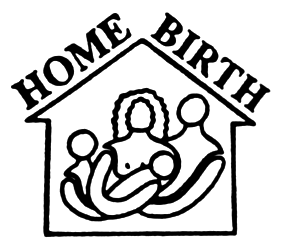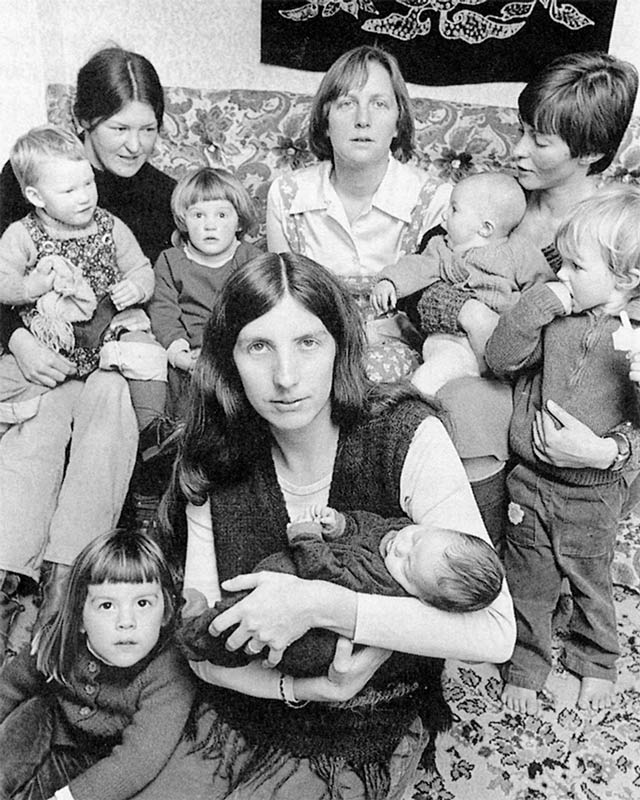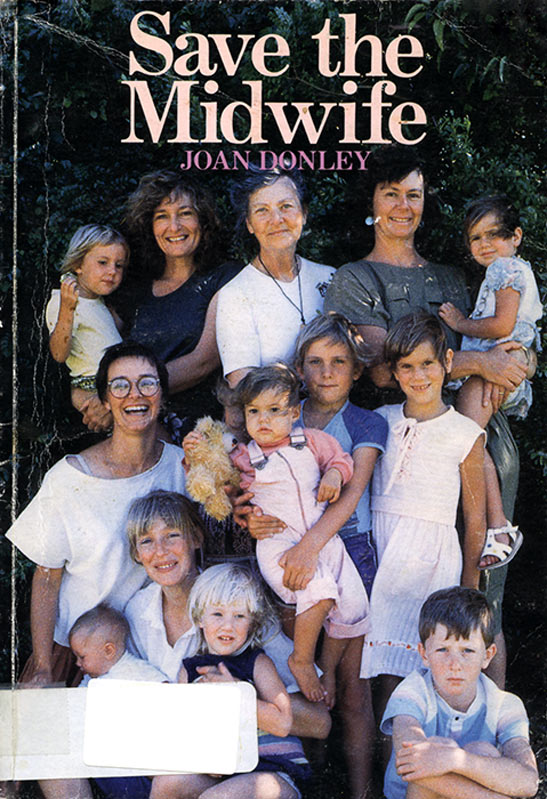
Home Birth Associations
1978 –
Theme: Health
Known as:
- New Zealand Home Birth Association
1978 – 1985 - Home Birth Associations
1985 –
This essay written by Joan Donley and Brenda Hinton was first published in Women Together: a History of Women's Organisations in New Zealand in 1993. It was updated by Elizabeth Cox in 2019.
1978 – 1993
The twentieth century home birth resurgence arose in the early 1970s, as a reaction against the increasing medicalisation of childbirth. In New Zealand, a policy of regionalisation directed women to large, centralised, high-tech hospitals, and forced the closure of rural maternity and cottage hospitals. The home was the only place where a woman could control her birthing process.
The demand for home births grew, and in 1974 three midwives – two in Auckland, one in Christchurch – took up domiciliary contracts. Because these were with the Department of Health, rather than local hospital boards, the midwives and the women they attended were outside the control of their local obstetric bureaucracies. This independence was a key factor in the survival of the home birth option in New Zealand.
In Auckland in 1978, a small group of home birth parents formed what they initially called the New Zealand Home Birth Association (NZHBA) to make sure this option did survive. [1] Their aims were to promote planned home birth as a safe alternative to hospital birth; to support women choosing home birth, and the midwives and doctors facilitating this choice; to educate the general public, health professionals and policy makers about the advantages of home birth; to research aspects of home birth; and to promote comparative studies of hospital and home births.
By 1980, six more home birth groups had formed independently in Christchurch, Dunedin, Wellington, Manawatu, Nelson and Tauranga, with women in several other areas eager to organise. This proliferation of groups reflected an international movement instigated by women wanting to reclaim the normality and intimacy of childbirth. At the first national conference in Auckland that year, seventeen delegates from the original seven groups agreed to formalise and incorporate the NZHBA. The Auckland group had already established links with groups in Australia, where the idea of Home Birth Week originated. Held in the last week in October, it featured a wide range of locally organised activities designed to publicise and promote home birth.

Alexander Turnbull Library, EP/1980/2116 .
Members of the Wellington Home Birth Association and children, July 1980. From left: Helen Staples, Jennifer Sage (midwife), Jessica McLean, with Vanessa Moon (front).
The NZHBA constitution provided for a national executive which would rotate annually to the branch hosting the conference, and would be supported by a capitation fee on all branches. One of its functions was to speak with one voice on issues of national importance. However, the 'one voice' soon became a problem, and by 1983 several branches felt that the national structure cost too much and was not working; they preferred groups which could function autonomously. Others saw the national organisation as providing clout, accessibility and respectability.
This controversy was finally resolved at the 1985 Nelson conference, when the NZHBA was wound up and reformed as a loose grouping of autonomous Home Birth Associations (HBAs), sharing common aims and a philosophy that birth is a normal biological event, not a pathological state requiring intervention; and that home birth is based on responsibly giving birth, rather than being passively delivered, and therefore requires self-awareness, a supportive environment, and flexibility. These organisational changes had little effect on the day-to-day work of the HBAs; all worked to ensure the continued availability of the home birth option, and to retain and improve the availability of fully subsidised maternity services in general.
The essential, special nature of the partnership between birthing women and midwives was valued and nurtured by all HBAs. Between 1978 and 1988, there was an acute nation-wide shortage of domiciliary midwives, because of the very low level of remuneration, frequent difficulties with medical peers, the stress of having to be on call 24 hours a day, and the professional isolation in areas with only one midwife. The HBAs adopted various strategies, such as running active or 'natural' childbirth classes, which swelled the demand for home births, and surveying attitudes among local doctors and hospital authorities, then lobbying and educating to gain the necessary back-up support. Some HBAs fundraised to buy the required equipment, in order to ease the financial burden for midwives. In other areas an HBA formed to support a midwife who had already taken out a domiciliary contract, publicise the service, and provide information and support for women choosing it.

Joan Donley, Save the midwife. Auckland: New Women’s Press, 1986 (sourced from Te Ara).
Home-birth midwife Joan Donley (back centre) was a leading midwifery practitioner and activist. Her 1986 book Save the midwife charted the history of midwifery in New Zealand and argued for a return to midwives' independence
The Nurses Amendment Bill 1983 would have placed total care of mother and baby with nurses who might or might not be midwives, and made midwifery merely a postgraduate nursing qualification, rather than a separate profession. Auckland HBA members formed Save the Midwives, to encourage midwives nation-wide to unite against the bill. Midwives and consumers together succeeded in getting the legislation revised, and the rift between domiciliary and hospital-based midwives began to heal. This battle became the first step toward the formation of the New Zealand College of Midwives in 1988.
Between 1978 and 1988, the HBAs lobbied continuously for a realistic level of remuneration for domiciliary midwives. Little progress was made until 1986, when the national conference subscribed $3000 and hired an industrial lawyer to renegotiate the old 1939 midwives' contract with the Department of Health, winning a substantial increase in fees.
The 1988 conference approved the establishment of regional Domiciliary Midwives Standards Review Committees, comprising equal numbers of health professionals and consumers; these committees reviewed annually the practice of all domiciliary midwives recommended by the HBAs. In 1990, with the HBAs' support, the New Zealand College of Midwives and a courageous Minister of Health, Helen Clark, succeeded in bringing into law the Nurses Amendment Act, which allowed midwives to practise independently of medical supervision.
This greatly improved the availability of the home birth option. [2] By 1992 there were 27 HBAs, with a collective membership of over 2000, functioning throughout New Zealand.
Joan Donley and Brenda Hinton
1994 – 2019
Following the successful advocacy among the home birth community and the legislative changes made by the 1990 Nurses Amendment Act, it became much easier for women, particularly in urban areas, to find a midwife who would support their choice for a home birth. A number of midwives previously employed by hospitals were able to work independently, which made home birth more available for women. [3] Planned home births increased from 2 percent in 1993 to 3.4 percent in 2014. [4] Nevertheless, the medical community remained polarised by home birth, and midwives maintained that in 2000 misinformation was continuing to be spread by doctors. [5]
Ironically, in the 1990s the increased availability of home birth options meant that Home Birth Associations (HBAs) became victims of their own success. Numbers of members, particularly active members, dwindled as home birth became easier to access. This was exacerbated by the general reduction in politically active community groups, as women began to return to paid employment earlier after the births of their babies. As one midwife who was active at this time observed, few new mothers ‘seemed to be interested in the politics of childbirth’. [6] Furthermore, some midwives, as newly independent practitioners with pay equity, no longer felt the need for the HBAs to lobby on their behalf. [7]
The response of the regional HBAs to the 1990s reforms was different in each region. [8] Some focussed on securing contracts with their Area Health Board, which funded them to be a provider of home birth services to women. They did this in order to keep midwifery services in the hands of women and their midwives, and prevent midwifery services from once again slipping under the governance of doctor-dominated providers. [9]
As a result, new forms of the HBAs emerged. In Auckland, after years of negotiations, some of the women who had previously been involved in the New Zealand Home Birth Association set up a new Maternity Provider Organisation, which held a contract with the Ministry of Health. It was one of the few new primary health care provider organisations which were consumer-led. In 2019 this organisation involved over 20 midwives (not solely home birth providers) providing Lead Maternity Carer services to women. [10]
In other regions, the HBAs became volunteer support groups, producing information and classes to encourage women to take up the home birth option, and providing solidarity and support to those who did so. [11] In 2009, for example, the Canterbury Home Birth Association was running morning teas, information evenings, antenatal classes, and a ‘care bank’ to support other home birth families, as well as taking part in Home Birth Awareness Week, and an internet forum. One of their campaigns in the 2010s was to advocate for 70 percent of risk-free women in Canterbury to be choosing home births by 2020. [12] By 2018, however, there was once again a severe shortage of midwives, for the much the same reasons as in the 1980s: relatively low pay, difficulties with medical peers, the stress of 24 hours on call, and professional isolation in some areas.[13]
Home Birth Aotearoa Trust
The Home Birth Aotearoa Trust formed in 2007 as a charitable trust, with a board of eight elected trustees, each of whom were involved in one of the volunteer-run regional HBAs. The trust aimed to increase the number of New Zealand women choosing to birth at home. From 2008, it held successive national home birth coordination contracts with the Ministry of Health, and used these for the positive promotion of home birth in New Zealand. It also held regional and national hui, maintained a representative on the national committee of the New Zealand College of Midwives, completed consumer advocacy work, promoted Home Birth Awareness Week and International Day of the Midwife, and maintained a website and magazine. It also aimed to have a voice in policy debates around maternity issues: in 2014 the trust spoke up against a coroner’s decision which made recommendations for sweeping changes to midwife training in New Zealand. [14]
In 2019, 25 regional HBAs were trust members, each of which work independently but with the trust’s support. The trust saw its role as being to ‘hold the kaupapa or spirit of the home birth movement in Aotearoa New Zealand by representing the collective interests of New Zealand’s volunteer-led regional home birth support groups and associations’. [15]
Elizabeth Cox
Notes
[1] By August 1979, the Auckland group had formed links with home birth groups in other parts of the country and was referring to itself as the Auckland branch.
[2] The Nurses Amendment Act 1990 removed the need for midwives to register with the Department of Health before working independently in the community, and provided pay equity, via the Maternity Benefit, with GPs providing maternity care. The number of independent midwives offering home birth services increased dramatically; however, no total for 1993 was available at time of publication.
[3] Banks, Maggie, 2000, p. 117.
[4] Ministry of Health, ‘Report on Maternity 2014’, Ministry of Health, Wellington, 2015. The proportion of Maori women having planned home births was slightly higher, at 4.4 percent.
[5] Banks, 2000, p. 120.
[6] Hinton, Brenda, personal communication, 2018.
[7] Donley, Joan, 1993.
[8] Daellenbach, Rae, 1999, p. 287.
[9] New Zealand Home Birth Association National Newsletter, Summer 1993.
[10] Hinton, Brenda, personal communication, 2018, and from website https://www.mamamaternity.co.nz/
[11] Daellenbach, Rae, 1999
[12] Birthplace: Home of the Homebirth Associations of Aotearoa, 2009–2011, ATL.
[13] Emma Blackett, ‘Midwives pushing for better conditions, but too busy to strike’, 7 Dec 2019, https://www.stuff.co.nz/national/health/109156294/midwives-pushing-for-better-conditions-but-too-busy-to-strike
[14] ‘Home Birth Aotearoa Statement on Coroner Report’, 3Feb 2015, http://www.scoop.co.nz/stories/GE1502/S00007/home-birth-aotearoa-statement-on-coroner-report.htm
[15] Home Birth Aotearoa Trust website, https://homebirth.org.nz/about-us/
Unpublished sources
Auckland Home Birth Association records, 1978–1992, held by Wise Woman Archives Trust, Waikato, https://www.birthspirit.co.nz/wise-woman-archives-trust/
Published sources
Auckland Home Birth Association Newsletter, 1979–1998, ATL
Banks, Maggie, Home Birth Bound: Mending the Broken Weave, Birthspirit Books, Hamilton, 2000
Birthplace: Home of the Homebirth Associations of Aotearoa, 2009-2012, ATL
Daellenbach, Rae, ‘The Paradox of Success and the Challenge of Change: Home Birth Associations in Aotearoa/New Zealand’, unpublished PhD Thesis, University of Canterbury, 1999
Donley, Joan, Save the Midwife, New Women's Press, Auckland, 1986
Donley, Joan, Herstory of the New Zealand Home Birth Movement, 1978–1991, NZHBA, Auckland, 1992
Donley, Joan, ‘The influence of the Home Birth Movement on Midwifery in New Zealand’, reproduced in National Networking Newsletter, Home Birth Association, 1993, ATL
Home Birth Matters: Home Birth in Aotearoa, 2014 –, ATL
Maternity Services Committee, Maternity Services in New Zealand, Board of Health Report No. 26, Wellington, 1976
Maternity Services Committee, Mother and Baby at Home: The Early Days, Board of Health Report No. 30, Wellington, 1982
New Zealand Home Birth Association National Newsletter, 1978–1990, ATL
Wellington Home Birth Association Newsletter, 1985-2015, ATL
Further sources
Home Birth Aotearoa Trust website: https://homebirth.org.nz/about-us/
Wise Woman Archives Trust, Waikato, https://www.birthspirit.co.nz/wise-woman-archives-trust/

Community contributions